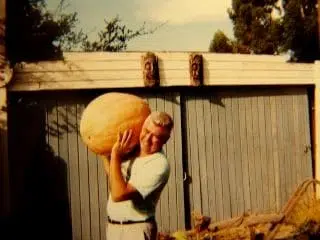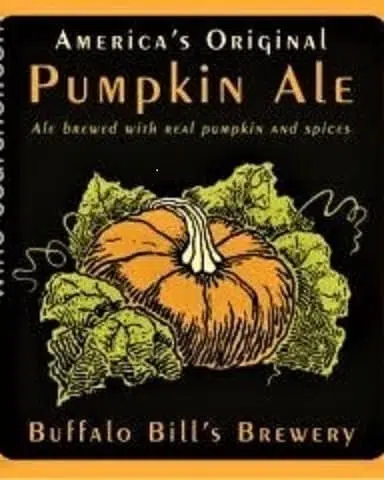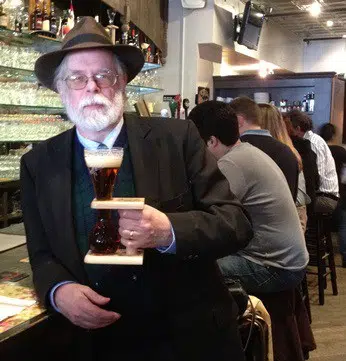My interview with the first bottle of “Pumpkin” Ale
Peter: I am here interviewing America’s Original Pumpkin Ale brewed by Buffalo Bill’s brewery in Chico, CA, in 1983. As you can see, this is a bottle of beer because caning wasn’t available to small breweries in the 1980s. And so, I searched and found a bottle of America’s Original Pumpkin Ale to ask it what it could tell me about what it was like to be the first of its kind.
Pumpkin ale: Thank you for having me here.
Peter: First of all, give me a little bit of background. What was it like to be brewed in 1983?
Pumpkin: Well, it was an exciting year. I guess the most significant headline was that Korean airlines flight that got shot down over Russia. I hear that it turned The American vodka business on its head. Some of the folks got all excited when the Baltimore Orioles managed to win the World Series board games to one over the Philadelphia Phillies. Out here in California, though, that didn’t make much of a difference. What was exciting was a great little movie called A Christmas Story. I have a feeling that one is going to be around for a long time.
Peter: Well, enough of background, tell me a little bit about yourself. I understand you were the very first pumpkin ale ever brewed in America.
Beer: Well, no, not exactly. Back in Colonial America, beer was brewed from almost anything that had sugar in it, particularly Sugar Pumpkins.
The fellow that brewed me Bill Owens had been doing quite a bit of reading, mostly early American brewing recipes.
What caught his eye was a recipe by George Washington using pumpkins to brew beer.
And so, he decided to try and brew a pumpkin beer. First, he needed a pumpkin. So, he went out and grew a humongous one. That’s pretty much how I came to be. And now you’re telling me that there are hundreds of pumpkin beers out there! I guess the crop of pumpkins must be astronomical to keep all those beers in pumpkin.
Peter: What about the rest of the information on your label? It says, “And spices.” What sort of spices were used in your brewing?
Beer: I guess you could say they were pumpkin pie spices. It’s a little embarrassing that Bill couldn’t come up with anything original. Still, I think that’s what makes me All-American. Some things, of course, a good beer just doesn’t ask questions about. I let the brewer worry all about that. I just hope that enough customers enjoy me so that I stay in production.
Peter: I can assure you that as long as Buffalo Bills brewing company was in operation, you were one of the stars. Of course, you were right up there in popularity with Alimony Ale, the bitterest ale in the world.
Beer: Come on now! I’m thankful for Thanksgiving, or else I suppose I would just be a straightforward Brown Ale. That’s how I started out.
Then Bill got the bright idea of adding pumpkin to the mash. But that was way before my time, so I guess you would have to ask him the real story behind things.
Peter: Thanks very much for chatting with me. And thanks for the suggestion to get in touch with bill Owens. I will give him your regards.
The actual story, as told to me during an interview with Bill Owens on 12 June 2007:
Of course, I already knew most of the story. Twelve years earlier I interviewed the fellow who brewed the first commercial “Pumpkin” beer and, it turns out there was pumpkin in the first brew but not in the finished product. I’ll let Bill Owens tell it in his own words.
The Bill Owens Interview:
The fact is that the pumpkin is an indigenous fruit to the North American continent. Native Americans, from sea to sea, found it useful to cultivate and consume it in all its various forms. The sugar pumpkin caught the attention of George Washington.
Being frugal, and politically correct (not buying English malt), he kept notes on pumpkin’s effect as a sugar/malt substitute in his home-brewed beer.
These notes came to the attention of a brewer named William (“Buffalo Bill”) Owens as he researched colonial brewing practices. His garden produced a pumpkin, and his notes rendered a “recipe” for pumpkin ale… I’ll let him tell the story.
Bill Owens: “It was in 1985 or 86. I was researching old-fashioned recipes brewing recipes and came across a book of recipes used by our colonial fathers, including George Washington. George Washington used gourds, and pumpkins, in his mash because of the starches they had.”
“So, I decided to do pumpkin ale. I’m a gardener, so I sent away to Atlantic Seed Company; that’s where you go to get those giant pumpkin seeds when you want to grow the 500 pounders.
So, I grew my pumpkin. Somewhere I have a movie of it, putting it on a little wagon and hauling it down to the brewery.”
The Pumpkin

“There I cut it up on the day before brew day, popped it in the oven, and baked it to get the starches to start to convert. On brewing day, I popped it in the oven a second time to warm it up again. When I got ready to mash, I chopped up into the chunks, about 3″ x 3” square chunks. Then I tossed them into the mash and mashed it in with the grains. I sparged around 170° and made my regular Amber ale.
It was a standard mash boil, but I didn’t use too many hops because I didn’t want the hops to take over. Then I fermented it, carbonated, and tasted it. There was no “Punkin” in the flavor!”
“Suddenly it dawned on me that the taste was one of America’s classic taste is pumpkin pie, and when you pick up a can of pumpkin pie there it is on the label.
It tells you that it has ginger and cloves and all those other spices and it. So, I walked into the supermarket and found a box of what was called pumpkin pie spices. I bought a whole case of pumpkin pie spices and went back to the brewery, put it in a coffee maker, and percolated it, ending up with 2 quarts of what I called “pumpkin pie juice.” This is what I was going to do to “dose” the beer with.”
“So, my next brew, I went through the same routine as my usual ale, but light on the hops. When I finished the fermentation, and the yeast had settled out because I didn’t want to put in with the yeast, I pumped it into the bright-beer tanks. Just before carbonation, I poured the “Pumpkin pie juice” in. When I served it, it was beautiful. The nose and mouthfeel were perfectly balanced, perfectly.”
Bill, I think it’s interesting that pumpkin ale is huge. The original “Buffalo Bill’s Pumpkin Ale” didn’t have any pumpkin in it.
Bill Owens: “There’s no way the pumpkin can add any flavor to a beer in the process. The starches in the sugars are just there, and they make alcohol, and that’s the end of that. That’s the end of the flavor profile.
People can talk about adding all kinds of pumpkin to their beers, but they’re just jerking you around.
The worst thing that you can do is put it in the boil because then you would break down all the starches and that crap would just go right into the heat exchanger and clog the heat exchanger. It would then cause bacterial infections in the heat exchanger, and it would be a major hassle. Then it could get into the fermentation vessels and contaminate your yeast.”
“You can’t really use pumpkin all by itself and make a beer or ale because it doesn’t give you any flavor. You might as well chew on the bark of a tree. There is no flavor in the pumpkin.
There’s no way you could get any of the flavors in the mashing or fermenting. Any flavoring has to be added after the fermentation.”
And that is the story of the first pumpkin beer.
Conclusion:
What started out as a beer using sweet pumpkin became an ale using the spices used in pumpkin pie filling.
Some beers just aren’t what they seem to be.



